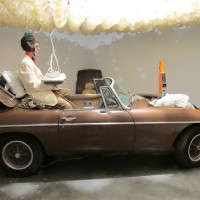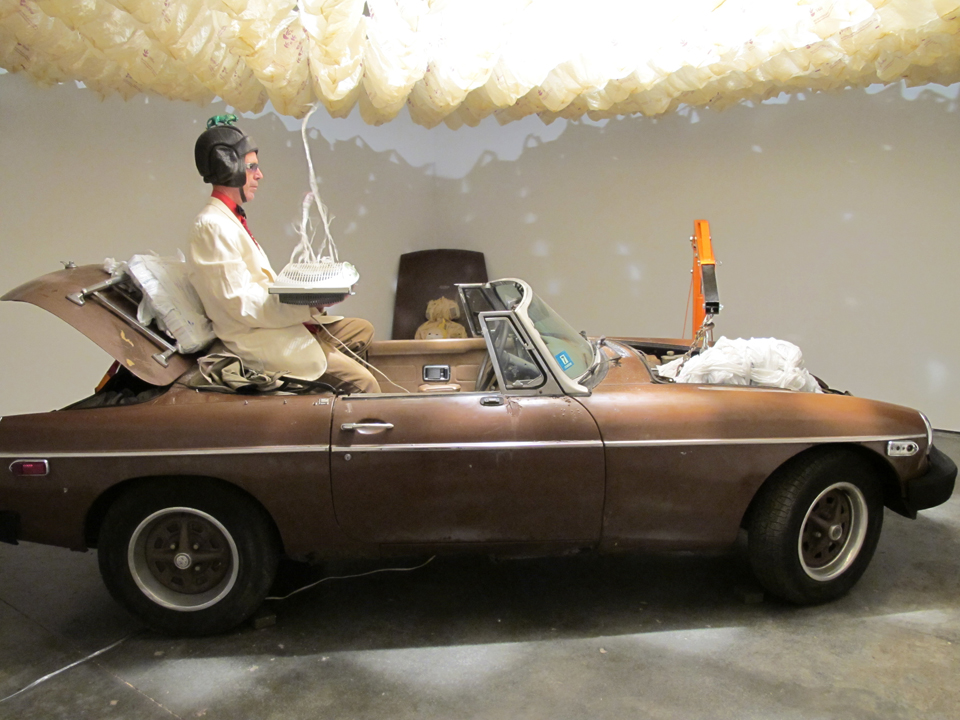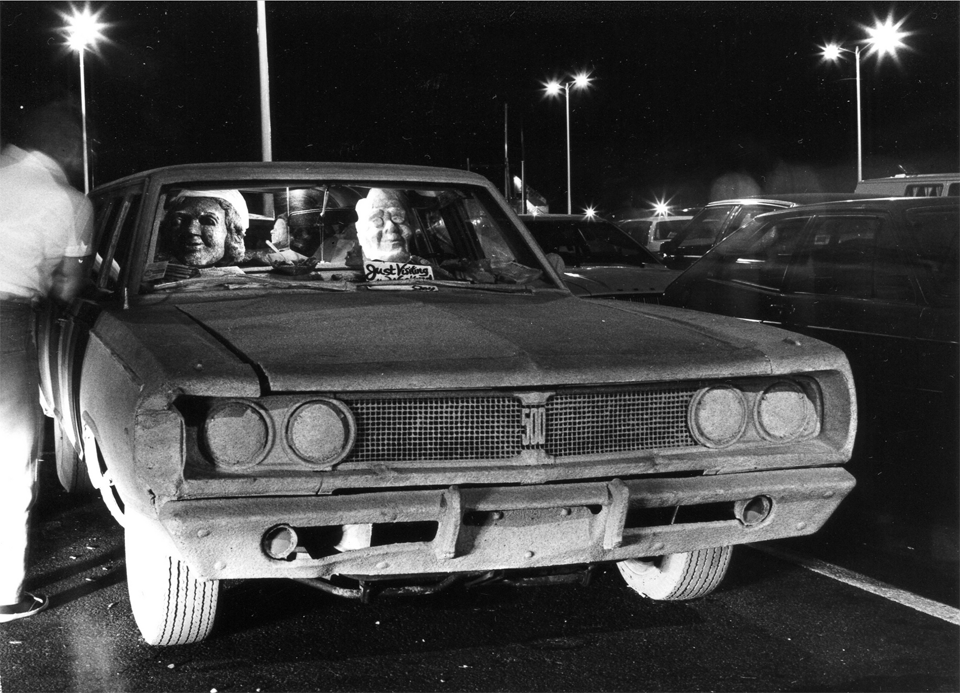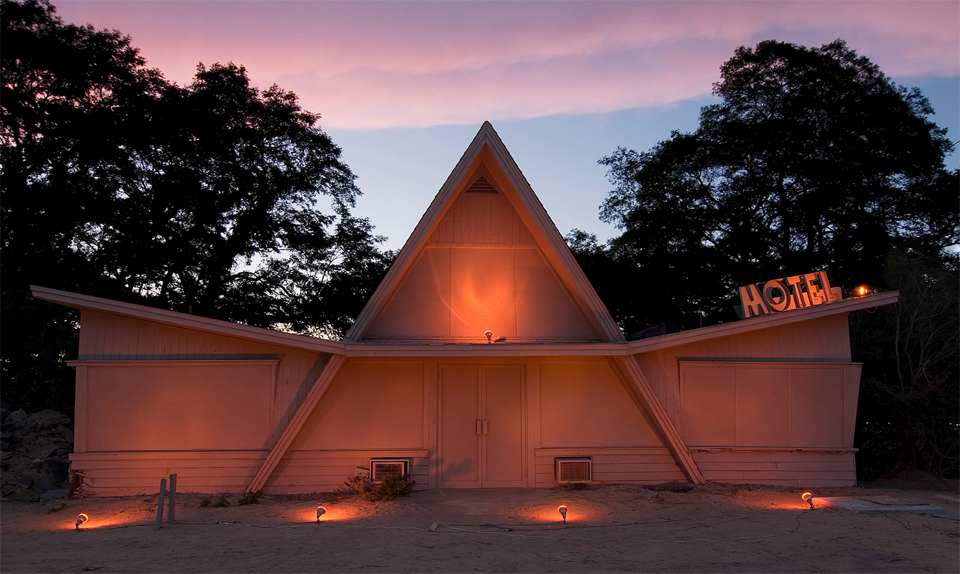Soothsayer of Society: A Conversation with Artist/Activist Jay Critchley


Deep Bones Opening Ceremony, “O Breaker of Bones,” 2011,
Freight + Volume Gallery, NYC. Photo: Adam Ryder.
In this highly polarized political climate of 2016, Jay Critchley’s uninhibited, fearless genius at making the world a stage — his uncanny, inspiring, even prophetic multi-media installations and performance events focusing on the environment, from pollution and dependence on fossil fuels to climate change, rising sea levels and corporate greed — has found its moment.
Jay Critchley, Incorporated, a traveling retrospective of Critchley’s geo-political concerns over three decades, will be installed, with added pieces done in collaboration with students and faculty, in the University Galleries, Florida Atlantic University, Boca Raton, FL, February 5 to April 2. The exhibition, curated by sculptor Bailey Bob Bailey, was originally installed at the Provincetown Art Association and Museum in 2015. See: www.fau.edu/galleries/Jay_Critchley.php
Critchley will also give a talk at FIU’s Miami Beach Urban Studios (MBUS), at 420 Lincoln Road, on February 19, at 7:00 PM. A beautiful catalog of the exhibition (published by Provincetown Arts Press, 2015) will be available at Critchley’s talk at MBUS, as well as at the exhibition at FAU.
It’s no surprise that ritual-loving Critchley, known to appear on stage in outlandish performance hats and ceremonial robes, was an altar boy. Critchley also appeared on legendary Ted Mack’s televised Amateur Hour singing barbershop harmony with five sisters. But perhaps his most formative hours were spent alone, in the family basement, crafting Popsicle-stick structures from street-scavenged materials, or exploring the potential of sand, the East Coast’s self-replenishing, abundant resource. Critchley retains his boyish delight in transforming castaway objects into sculpture.
Between 1981 and 1984, Critchley installed his sand car sculpture series, Just Visiting for the Weekend, in Provincetown’s midtown waterfront parking lot, MacMillan Wharf, paying the “townie” parking fee before appropriating a space for what became his personal open-air gallery for over four years (and four uniquely themed cars) — simultaneously a tourist favorite and cause célèbre.

Just Visiting for the Weekend, with the Sand Family (Ron & Nancy Reagan), Sand Car Series, MacMillan Wharf Parking Lot “Gallery,” 1982. Photo: Rachel Giese Brown.
The Town Manager and the Chief of Police insisted Critchley remove the super-sized, sand-filled, and sand-encrusted vehicles. “Nonsense, there are no legal violations,” proclaimed the art-friendly Town Moderator, also Critchley’s attorney. Relishing his first artistic dip into a battle over First Amendment rights, Critchley embraced the media’s role in helping blast sound alarms.
Curator Bailey Bob Bailey calls Critchley a “Soothsayer of Society.” Ken Johnson of The New York Times has referred to him as a Cassandra — even when few are listening, Critchley’s sinuous ideas overtly “. . . deplore our addictions to oil, drugs and competition,” Johnson wrote.
Critchley’s “soothsaying” performances include Miss Tampon Liberty, which traveled to Liberty State Park in New Jersey for the Statue of Liberty Centennial, and the Massachusetts State House in Boston where he, as Miss Liberty, sponsored legislation to ban “non-biodegradable feminine hygiene products.” Critchley was adorned in Dior-worthy regalia, hand-sewn from thousands of faded pink, ocean-polluting plastic tampon applicators gathered from Northeast beaches, that rustled while he walked and danced.

Miss Tampon Liberty, artist at Liberty State Park, NJ, with gown of 3,000 plastic tampon applicators washed up on beaches, 1989.
Another performance piece, Beige Motel, involved the takeover of an abandoned 1950s motel, which Critchley encrusted with sand before the buildings could be demolished. This fading cultural artifact became a manifestation of the symbiosis between tourism and the automobile.

Beige Motel, sand-encrusted 1950s motel before demolition, Rt. 6, North Truro, Cape Cod, MA. 2006 Photo: Kevin Thomas.
Critchley followed the Beige Motel with the transformation of a soon-to-be-demolished 1950s concrete bathhouse in the Cape Cod National Seashore, into an exhibition space for artists, with installation and performance spaces reminiscent of a Whitney Biennial. After ten days of creative mayhem, the bathhouse with its eroding beachfront, heavy with the weight of history, was also torn down.
As a solo project designer, Critchley creates and displays imaginary provocative conceptual plans. “Why not transform car tunnels into carbon-mitigating greenways and a recording studio?” Critchley asks, envisioning Boston’s mammoth “Big Dig” underwater tunnel project as the “Big Twig.” “Art” with a capital A, tucked away in museum vaults and isolated from public dilemmas, is not his thing.
In 1988, Critchley organized the first “Swim for Life,“ which has grown into the annual Provincetown Harbor Swim for Life & and Paddler Flotilla, a fundraiser which has raised millions of dollars that are given to organizations battling AIDS. Swim for Life is sponsored by the Provincetown Community Compact, an organization Critchley founded that nurtures the arts, social service, and preservationist communities.

Provincetown Swim for Life & Paddler Flotilla, annual benefit for AIDS, women’s health and the community; start at Long Point, Provincetown Harbor, 2008. Photo: Mike Syers.
Florida has proved hospitable to Critchley’s collaborative, insurgent practice. With the encouragement of Rod Faulds, Director of the University Galleries, Florida Atlantic University, Critchley has collaborated with faculty and students from the sculpture, theater, music, and literary arts departments to create sculptures and performance pieces inspired by his fictional memoir, Uncle Jay. He will also read from his soon-to-be-published book in a reading sponsored by the literary arts department, which will be accompanied by performances of the collaborative pieces.
As if to support Critchley’s concerns for climate change, when I interviewed the artist in early January, 2016, the temperatures in New England were hovering at a disconcerting fifty degrees. I’ve been thinking about the ways Critchley continues to link art and environmental activism, centered on pollution and degradation of the planet — the throw-away tampon applicators, the automobiles encrusted with sand and parked in his public parking lot gallery or entombed in gallery settings, or his call for “Global Yawning,” a traveling installation first exhibited in 2008 at the Boston Center for the Arts. A clarion call clothed in humor, Global Yawning provokes consideration of a collective planetary yawn as a means to cool the planet and restore climate balance. “The personal is planetary,” Critchley reminds us.

GLOBAL YAWNING for a small planet, “a new day is yawning.” Installation view: multi-channel videos, 5 minute loops; digital photos: 89 x 59 inches, Boston Center for the Arts, 2008. Photo from Mill’s Gallery catalog.
Susan Rand Brown: You’ve been exploring environmental degradation with grace and wit for decades. If we are witnessing the inexorable march of global warming and planetary devastation, what keeps you from getting discouraged?
Jay Critchley: I grew up outside in Connecticut. With nine kids, my mother’s mantra was, “Get out of the house!” The drama and unpredictability of the Cape Cod weather and landscape are in my DNA. My concern for the Earth’s sustainability keeps me appreciative of each day I have to revel in its splendor. It’s about quality of life for all, including environmental justice, inequality, and countering the über-capitalistic tendencies of our democracy. Speak the truth, spread the joy, and let your hair down (what’s left of it).
SRB: If you’d been invited to Paris for the climate conference, how would you have participated?
JC: I would organize a group to promote and demonstrate with one word, “Condoms.” There was a lot of grassroots momentum going into the conference and a structural milestone was created, but one strategy that was not emphasized was overpopulation. Condoms, family planning. The London School of Economics reports that condoms offer the cheapest and most immediate strategy to curb greenhouse gas emissions. Pope Francis’ notable encyclical on climate change continued the Catholic Church’s banning of any form of contraceptives! This is morally outrageous, on top of this policy’s devastation in relation to HIV/AIDS. Maybe it’s time to revive my patriotic Old Glory Condom Corporation, and the Blessed Virgin Rubber Goddess, not just to protect and save lives and protect the rainforest’s rubber trees,
but to hold back population — 40% of worldwide
pregnancies are unplanned!
SRB: In a recent interview, a New York Times writer described someone as a “stove” rather than a “refrigerator,” a person who’d rather “cook” than “keep.” I immediately thought of your retrospective at FAU, packed with so much conceptual invention preserved in material form. You’re always cooking, Jay! But now we see you’re also keeping. How did you manage to preserve so much? And how much do you regret not having kept?
JC: It’s the New England weather again — cook in the summer, freeze in the winter. I thrive on both—I haven’t succumbed to air-conditioning yet. You know, early contemporary performance artists’ actions and interventions were private and ephemeral, a reaction to the public spectacle of the media. Some of my early work was undocumented. But my intention has always been to collaborate with the media and the public in injecting alternative ideas and images of political and cultural importance — a call to action. I was fortunate to have a freelance photographer, Kathy Chapman, who was dedicated to capturing artists’ actions, events, and unpredictable happenings.
SRB: What do you advise early career artists about balancing these realms of cooking and keeping? Or shouldn’t they worry about keeping at all, just keep on doing the work with the stove turned high?
JC: I hate cooking, for me it’s basic beans and salads…let’s eat raw. There are other ways to turn up the heat.
SRB: You sent me a National Public Radio advisory a while ago about National Toilet Day.
I’ve always wondered about your fascination with abandoned outhouses, septic systems, anything that represents how we deal with, and hide from view, our excrement. In Ancient Evenings, Norman Mailer’s fictive account of the young Adolph Hitler, human waste is perhaps over-analyzed as “undigested memories and feelings.” How do you explain your obsession with systems of elimination?
JC: Those undigested memories and feelings eventually end up in the compost pile, recycled. Elimination is just one part of the life cycle — life, death and rebirth — as with my use of the Christmas tree in my annual Re-Rooters Day Ceremony. As we speak, I’m preparing for my 33rd Re-Rooters Day Ceremony (following the 12 Days of Stockpiling). This burning, singing, chanting, and ranting ritual is an integral purgation from year to year for myself and the hearty souls who come out to the sand flats of Provincetown Harbor in the dead of winter. Last year’s theme was: “Hands Up! We can’t breathe.” It’s a time to “Textify!” It’s a rousing and visceral cleansing, a time to clean the slate. Pick up the pieces and ask, “Have we lost our desire for eternity?”

29th annual Re-Rooters Day Ceremony, Super PAC Rats (repuS CAP staR), Provincetown Harbor, January 7, 2012. Photo: Nancy Bloom.
By the way, National Toilet Day is sponsored by the United Nations and is a call to arms. One in three people worldwide do not have access to clean sanitary facilities and clean water. It’s an environmental and public health issue.
I co-hosted a radio program on WOMR-FM called Scat Chat. Its theme song was Please Release Me, Let Me Go by Engelbert Humperdinck.
SRB: Your earliest artwork involves sand, a ubiquitous foundational material whose potential most artists overlook. Cape Cod has sand in abundance, of course, and so does Florida. Has Florida’s abundance of sand renewed your attachment to this beige ready-made or inspired any new ideas?
JC: Picture the waterfront hotels on Miami Beach, all encrusted in coral-rich sand, glowing in the morning sun. The waterfront strip of hotels happens to be the highest point around, and with sea level rise, this strip would become an island — Miami Beige, Island of Abandoned Luxury!
SRB: Rod Faulds [the Director of the University Galleries at FAU] has collaborated with you and supported your work for many years. Your friendship began with a multi-ritual Endangered eARTh Symposium, when he was the Associate and Acting Director of the Williams College Museum of Art. This was at a time when you were launching the “Old Glory Condom Corporation” in response to the government’s unwillingness to acknowledge the AIDS crisis.
You actually manufactured, advertised, and marketed packaged samples of condoms, with a logo of the American flag imprinted on an unfurled condom. “Old Glory” became one of many corporate ventures you successfully established and even trademarked over more than two decades ago.
Chris Busa, co-founder and publisher of Provincetown Arts, featured your work in the magazine’s 2011-12 issue. In Art, Ritual and a New Global Yawning, Busa investigated your tweaking of corporate over-reaching: “Critchley’s work manipulates the manner in which values are expressed, twisting them into business plans that mimic corporate logic, sometimes in hilarious ways. . . . The earnest missions of corporations are mocked in a deadpan, guilt-free, and unselfconscious destabilizing reality by offering a play on reality.”
Looking back, what keeps motivating you to speak truth to power decade after decade — to create and often trademark business plans, logos, and communal rituals intent on re-balancing collective amnesia in the face of state-approved corporate fiction?
JC: One of Old Glory’s slogans was, “Never Flown at Half Mast.” It can be hard to be a man, always at attention! But I happen to see the glass as half-full — it’s in my genes. I’m drawn to the Catholic Church’s mysterious concept of the “Mystical Body,” extending it to embrace the earth and all of humanity. We’re in this together.
SRB: That’s perfect. Ron Faulds does refer to you as “Our Spirited Guide,” acknowledging your spirit and sense of fun, humor holding hands with the absolute seriousness of your mission, captivating even the skeptics. Others have called you a civic priest. I picture your lobster claw and seagull-feathered headpieces, your gowns carefully assembled from what nature and local landfills toss your way — you’ve always been a locavore in your scavenging.
Faulds also points to something about your most recent work as a teaching artist, where you are collaborating with a new generation of art students, many of whom will follow your lead in understanding creativity as an open door to the as-yet-unknown self. This includes their own roles as concerned, questioning citizens — “activists” if you will.
When did you begin to think of yourself as opening a door for younger artists?
JC: Over the years, my role has been more of a collaborator than a teacher, working on a project basis with artists of various disciplines and levels of achievement. Rod organized a group of faculty who were interested in my work and the possibilities for collaboration. Students in Julie Ward’s sculpture class were asked to read Uncle Jay and develop some ideas for sculpture.
We also developed the idea of fabricating a piece in the shape of my backyard septic tank, which I repurposed as a Theater in the Ground. The structure is beehive shaped. It will be part of the show and used as a performance space. FAU theater director, Desmond Gallant, wrote a short script based on the text from Uncle Jay, which will be performed by theater students at the opening and other times throughout the show. Jamie Cunningham, who is a professor of music, made a trip to Provincetown to record and video his own music and digitally produce a program that recreates the sonic signature of the tank. This will allow him to run any music or audio through the program, which will sound as if it were being performed in the space.
SRB: Who were your role models and influencers?
JC: My Uncle Cliff was a rugged, jack-of-all-trades who took me under his wing. He and my Aunt Geri invited the Critchley clan of nine kids to their primitive island retreat each summer. I worked with him to restore an aging wooden house and build up protective rock walls, using only hand tools. No electricity or running water — like the dune shacks in the Cape Cod National Seashore. And what could be more performative than the high rituals of the Catholic Church, and being an altar boy through high school. Of course, it was my dad who taught us how to sing four-part harmony, which led to years of performing on stage and in nursing homes.
I identify myself as a born-again artist, coming out as an artist at age thirty-three in Provincetown. The town is an incubator and laboratory. The community of artists became my mentors. I hosted a radio program on the local community radio station, ART Focus (Artists Reveal Themselves), interviewing about fifty artists and visiting their studios. This gave me the confidence and context to jump into the fray.
SRB: When I read that New York City’s Museum of Modern Art was undergoing yet another renovation, aiming to slice the art historical pie more broadly, to include material culture — and would perhaps exhibit a Jaguar (king of the automotive jungle) as part of this mix, I immediately thought of you, Jay, your Deep Bones ritual, performed in NYC’s Freight + Volume Gallery. You wrapped each engine part of a 1979 MG sports car with recycled plastic shopping bags, displayed and then returned them to the eviscerated vehicle, now mummified with additional shopping bags. The catalog for your current exhibition describes this as “an exploration of society’s voracious appetite for hydrocarbons.”
If invited by MoMA (or even performing street theater in front of the museum’s 53rd Street entrance, as the Guerrilla Girls and Yoko Ono famously did) how would you display and label this energy-hungry inclusion?
JC: With a Ceremony:
O Breaker of Bones (O rekaerB fo senoB)
O Swallower of Shades…, I have not slain people…, O Breaker of Bones…I have not stolen food…, O He-who-is-Blood who came forth from the place of slaughter, I have not done grain-profiteering….
We confirm that you have witnessed self-pollution, eavesdropping, stolen land, nonversations and chaos, and call on the great Sun God RE – that you will emerge victorious from these trials and happily return to the Field of Reeds on the Nile.
Textify! Textify! Pre-hab Neanderthals with Benefits…
Have we lost our desire for eternity?
Have we lost our desire for eternity?
SRB: Why do most museums avoid (are frightened of) your message and approach?
JC: My work is not targeted for museums and galleries. It was created for the media, the public, the body politic. My focus is on interjecting my ideas, images and actions into the mainstream conversation. It is conceptual, performative, often ephemeral. The media is a collaborator. My use of the corporate structure is a vehicle and platform that gives me a bigger voice and more authority as a CEO. It is a critique of growing corporate influence I recognized in the early 1980s. My work hovers outside the fine art world. It calls for action.
SRB: In December 2015, The New Yorker published a well-researched piece by Elizabeth Kolbert titled The Siege of Miami. South Florida’s waters will continue to rise, causing increasingly hard-to-ignore and eventually permanent flooding, she argues.
Kolbert mentions the role of FAU and FIU [Florida International University] researchers in tracking sea level rise in relation to current (and ineffective) flood-control capacity. She also mentions Governor Rick Scott’s ban on terms like “climate change,” an absurdity you seized upon in early 2015, during a FAU residency.
“Society is a canvas,” is something you said to me last spring, around the time you were thinking and talking about energy and the environment in South Florida. Seizing the moment, you were busy designing a Mobil Warming logo, a visual mash-up of the Florida state seal and Mobil’s own eye-catching red and blue logo.
“I choose what issues I want to frame, and how to create form and function within that,” you said then. “I’m not a painter. I do everything but paint.”
As Critchley continues on the journey to restore planetary balance, a bounce in his step and a twinkle in his eyes, those who follow his practice look to 2016 as a Critchley moment, leavened with communal rituals embodying a counter narrative. With stakes never higher, the personal becomes ever more pressingly political; or as Critchley puts it, “The personal is planetary.” We’re all in this together.

